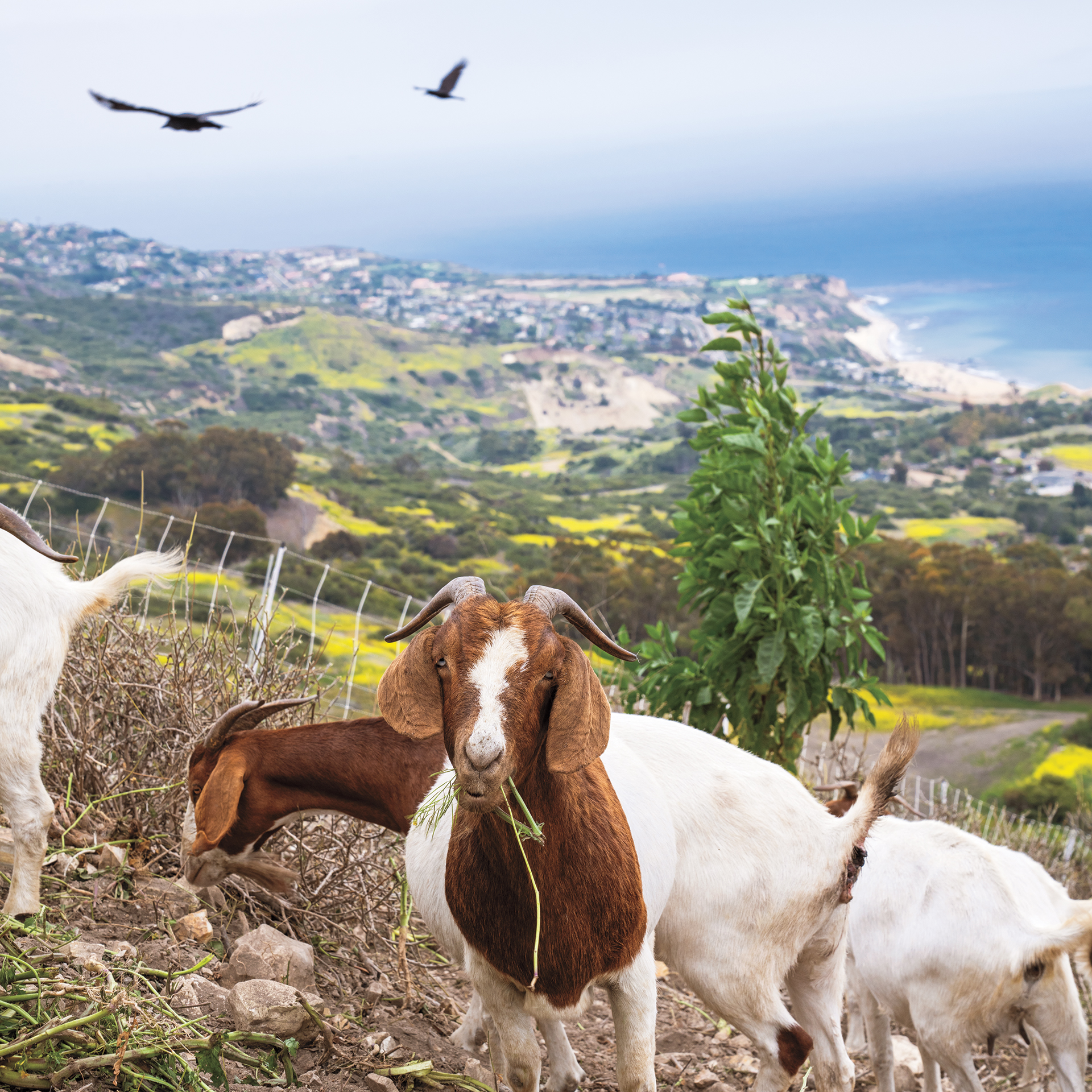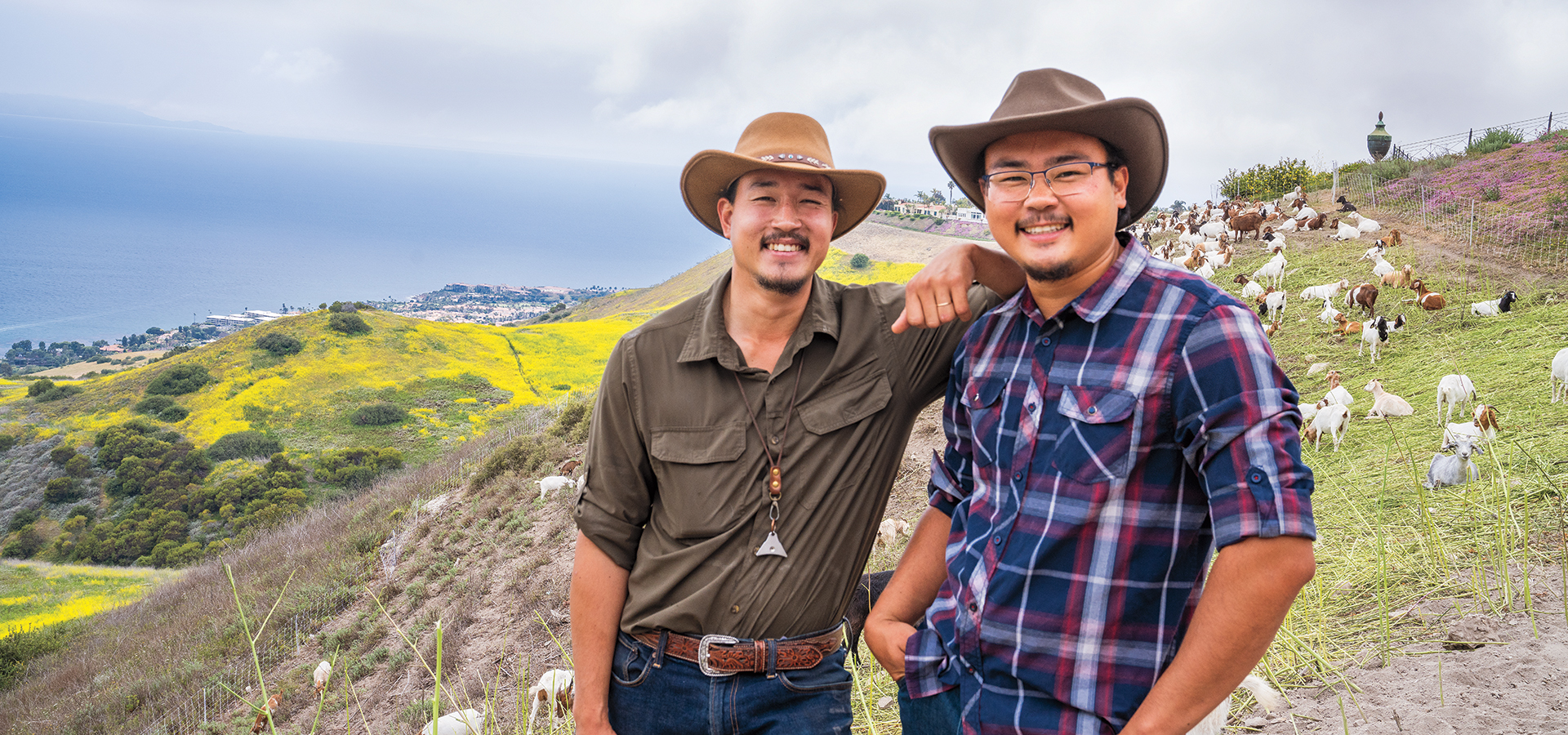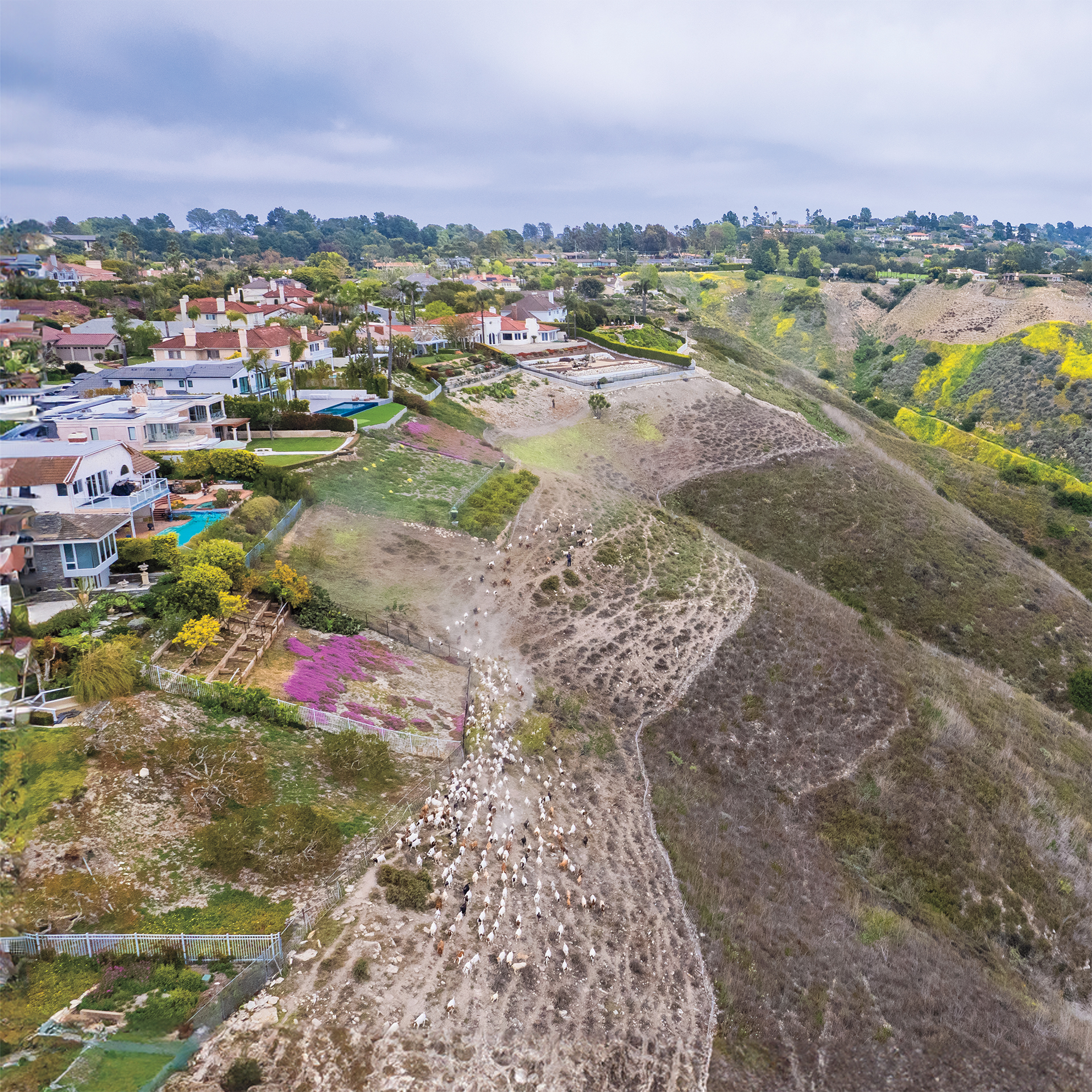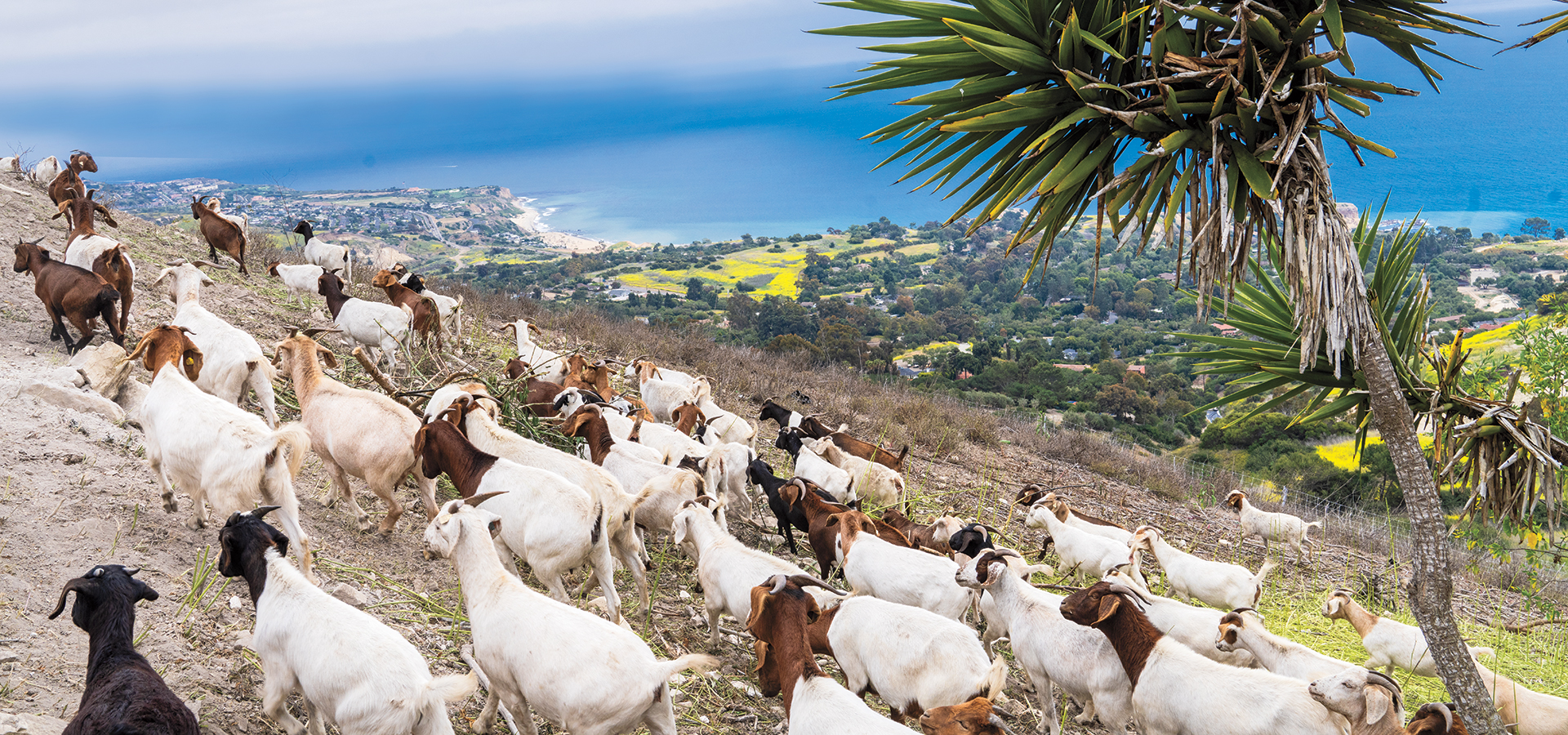In the months following the devastating wildfires earlier this year, South Bay residents and local officials heightened their awareness of fire safety. To support ongoing risk management efforts, some have enlisted the services of Fire Grazers Inc. and their herd of hungry goats for brush clearance on the Palos Verdes Peninsula.

“We have worked regularly on the Peninsula for 16 years, but this year is the first time we have worked in some locations since 2019,” says co-owner Michael Choi. “Because of the recent big fires, we were asked to return to clear those hard-to-access sites and canyons. We were also contacted by the school district.”
Michael was attending high school in Torrance when he assisted his father, Mark, with the start-up of the family goat business in 2009. “My dad had a business in the food service industry that was heavily impacted by the 2008 housing crisis,” Michael shares. “He decided he wanted to do something that would be self-sustained, with the ultimate goal of having a food farm to grow everything we consume. The goats were the way to facilitate this transition.”
Mark initially rented goats from his mentor, the late Michael Canaday of Living Systems Land Management in Fresno County, who helped him get his first two jobs with the Palos Verdes Peninsula Land Conservancy (PVPLC) and the city of Rancho Palos Verdes. Four goats became 50. He then decided to purchase 300 goats after the family acquired enough land for them to live on.
“We drove our stock trailer to pick them up with multiple trips to get them to our ranch in Mariposa,” Michael recalls. “Between 2009 and 2012 there was a lot of uncertainty, but my father, my brothers Aaron and Joseph, and I kept working at it until everything eventually kicked into gear.”
There are now approximately 1,000 goats in the Fire Grazers herd, which changes with the breeding season. The majority of them are Boer goats, a typical breed with brown heads and white bodies, along with a few Spanish, Kiko and Alpine goats. They have an average life span of 10 to 15 years and are regularly monitored by livestock veterinarians. Their general disposition is docile and kind, especially those that are bottle-fed.

“We try to make sure that the babies are born in October or November and not during the fire-grazing season, which is typically from March until September,” Michael explains. “We separate the males until May, but sometimes a male sneaks into the herd.”
Goats eat dry brush and are especially adept at clearing difficult terrain to aid with fire prevention. According to Michael, 300 to 400 goats are released at a location together and can consume 1 acre per day.
“Looking up at the hillsides and seeing the lines of demarcation where the targeted grazing occurred is relieving,” says Captain Andrew Olvera at Fire Station 53 in Rancho Palos Verdes. “Having those consistent lines of defensible space literally plays into the Los Angeles County Fire Department’s plans of attack if a fire were to occur.”
The goats have a hearty immune system and unique four-chambered stomachs that allow them to eat most vegetation, including troublesome invasive plants. “Star thistle is one of their favorites,” says Michael. “When we started working in Palos Verdes, it was a much bigger problem than now. The goats did not eradicate it, but they took it down several notches. Fennel and mustard have also been difficult for the PVPLC to manage, but the goats enjoy both—and fennel is like candy to them.”
While grazing, their diet is supplemented with bales of alfalfa hay, salt blocks and plenty of water from water tanks that Fire Grazers personnel take to each location to fill large drinking containers.
Protecting native plants is also a consideration when releasing the goats to do their job, though fire safety is the first priority. “We work closely with the PVPLC to map out where we set our electric fences to contain the goats and deter wildlife, which sometimes goes around protected species,” he says. “For example, the Palos Verdes blue butterfly needs specific native plants to survive. The way the goats disturb the soil near the plants helps them thrive.”

Successful management of the goat business is dependent upon Fire Grazers dogs that have two distinctly separate jobs: guarding and herding. Great Pyrenees, Anatolian shepherds and Akbash breeds act as livestock guardians, each weighing over 100 pounds. They live with the goats full time, and no training is needed because they instinctively protect anything they grow up with.
Border collies herd and intently move the goats with commands from Michael or another handler. “The border collies are very intelligent but rascals,” says Michael. “Unlike the guard dogs, they must be trained to do their job, so we keep an eye on them. They move the goats from one location to another, such as driving them across a canyon or into trailers, while keeping them together and safe. If a fence is damaged, the dogs move them away from the spot while we fix it. And if a goat gets out of the fencing, a dog will round it up. We cannot leave the herding dogs in with the goats 24/7 like the guard dogs. If we did, the goats would never sleep.”
According to Michael, the goats are moved every two to three days and they cover up to 100 parcels of land in Southern California per year, primarily in Los Angeles County. The constant movement is natural to their herd mentality and makes for happy goats.
“The way we move them around mimics the way they are supposed to live,” he adds. “They get to travel, have ocean views, and they eat for free. They are living the life!”
Downtown Manhattan Beach Holiday Shopping Guide
The ultimate coastal escape—just a stone’s throw from the sand. Whether your goal is shopping, dining, beauty or relaxation, Downtown Manhattan Beach Shopping & Dining Guide blends fun, indulgence and tranquility. Come see us soon!
The South Bay Gives Back
During this holiday season of giving, we take a moment to celebrate the organizations and nonprofits that pay it forward in our community. Their generous dedication of time, service and resources for worthy causes inspires us all and deserves our deepest gratitude and appreciation.
Holiday Wish List 2025
Our annual holiday gift guide highlights the latest trends in fashion, jewelry and home goods available at local retailers for all of your gifting needs. Don’t let the season’s best and brightest pass you by!









